
Ah yes, summer is finally here. And with it comes popsicles, sunscreen lotion, and the annual emergence of the one pest that sets every gardener on edge – the Japanese beetle.
These shiny copper and green eating machines put Erik Larson’s hungry caterpillar to shame. In only a matter of weeks, these invasive beetles leave a path of skeletonized plants in their wake before burrowing into the ground to leave eggs for next year’s onslaught.
So, what’s a gardener to do when they spy the first Japanese beetle of the season?
Take a few deep, calming breaths. Then go to war, of course.
But if you’re an organic gardener who tries to limit their reliance on harsh insecticides, that war can be tough to wage. Many of the most effective controls against Japanese beetles are hardly good for the environment or the declining pollinator populations. Many pesticide options that kill Japanese beetles also kill beneficial insects that come in contact with them.
That doesn’t mean you have to sit back while these mini-monsters defoliate your favorite knock-out roses year after year. Let’s look at the pest control methods available to the organically conscious gardener and form a plan of attack.
The Japanese Beetle
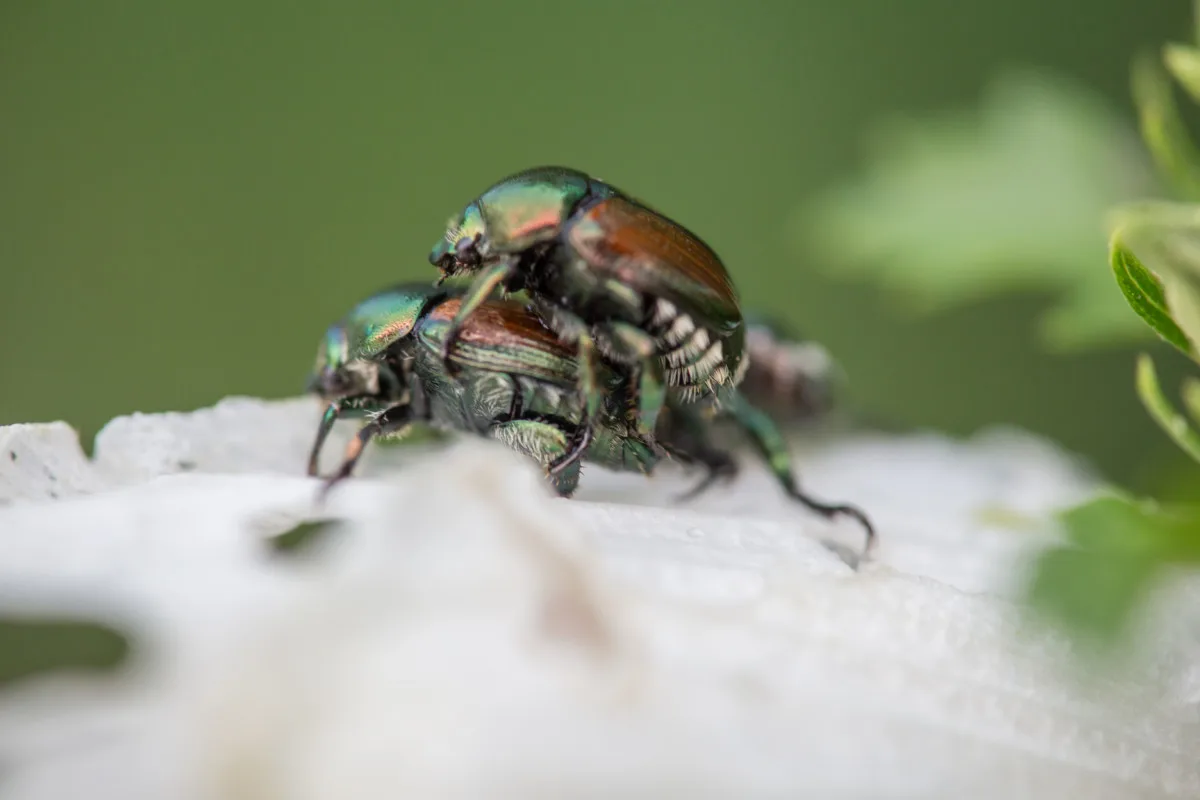
When it comes to war, it’s always important to understand your opponent. So, before we take a look at how to battle Japanese beetles, let’s take a look at their life cycle, what plants they eat, when they show up and why they’re such a pain here in the states and Canada (and plenty of other places beyond Japan).
Japanese beetles (Popillia japonica) have been in the United States since the early 1900s when some grubs hopped a free ride across the ocean on some iris bulbs headed for America. (A-Z Animals)
When the larva emerged as an adult beetle, they found plenty to eat. Since their natural predators back home, a variety of wasps and flies native to Japan, were nowhere to be found, the beetles flourished, spreading across the states over the years. Now they are an invasive species in the US, Canada and Europe.
Life Cycle of the Japanese Beetle
The Japanese beetle has four stages in its life cycle, two of which can be destructive to your lawn and garden. Most of the beetle’s life is spent underground, only emerging in the adult phase we all know and loathe.
Eggs
The eggs are cylindrical and white and are deposited in the soil, where they will absorb moisture from the ground as they develop. The female adult beetles burrow into the ground to lay their eggs, which will hatch within a couple of weeks.
Larvae
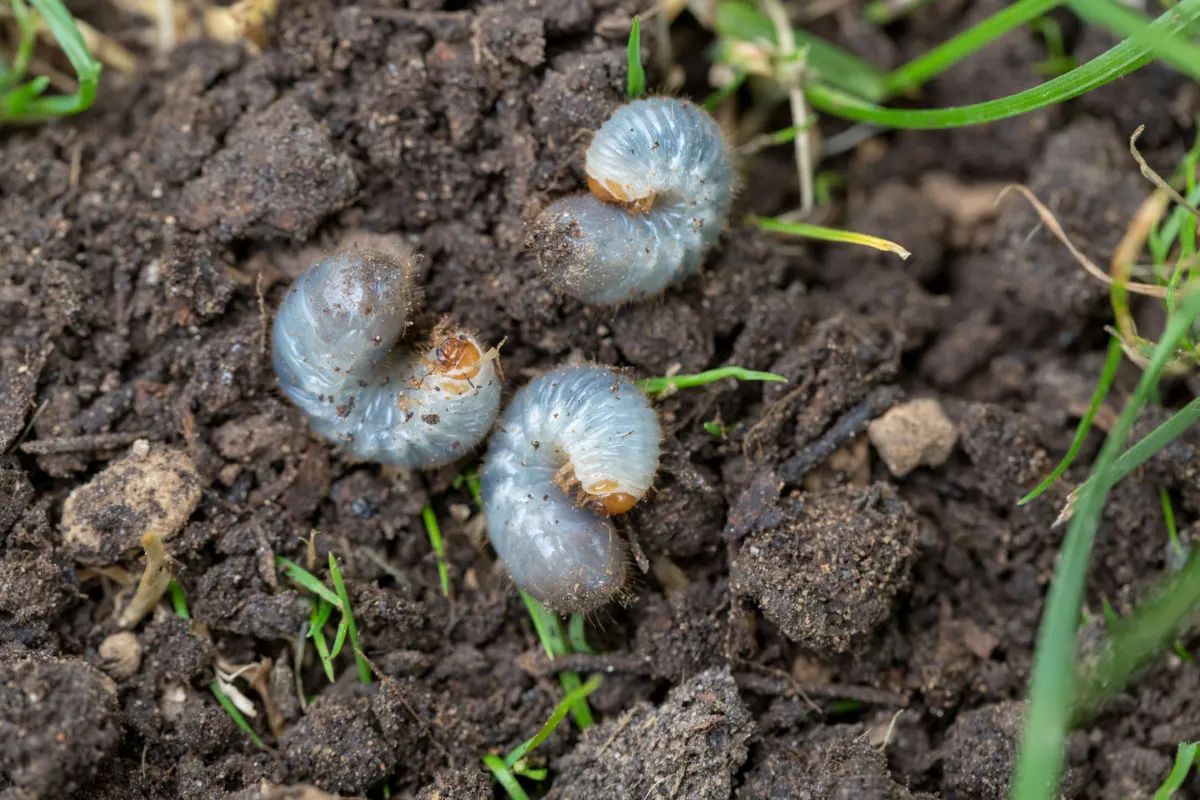
These are the classic white lawn grubs with a brown head that you see each year. However, the larger ones you see in the spring are generally grubs that have survived the winter. A closer look under the turf in the late summer and fall will find the much smaller hatch from the current year’s eggs. These will winter over and then show up next spring.
You may see brown, dying spots on your lawn from the grubs feasting on the roots, or you may have skunks, moles, and other critters digging up your lawn to get these tasty treats.
Pupae
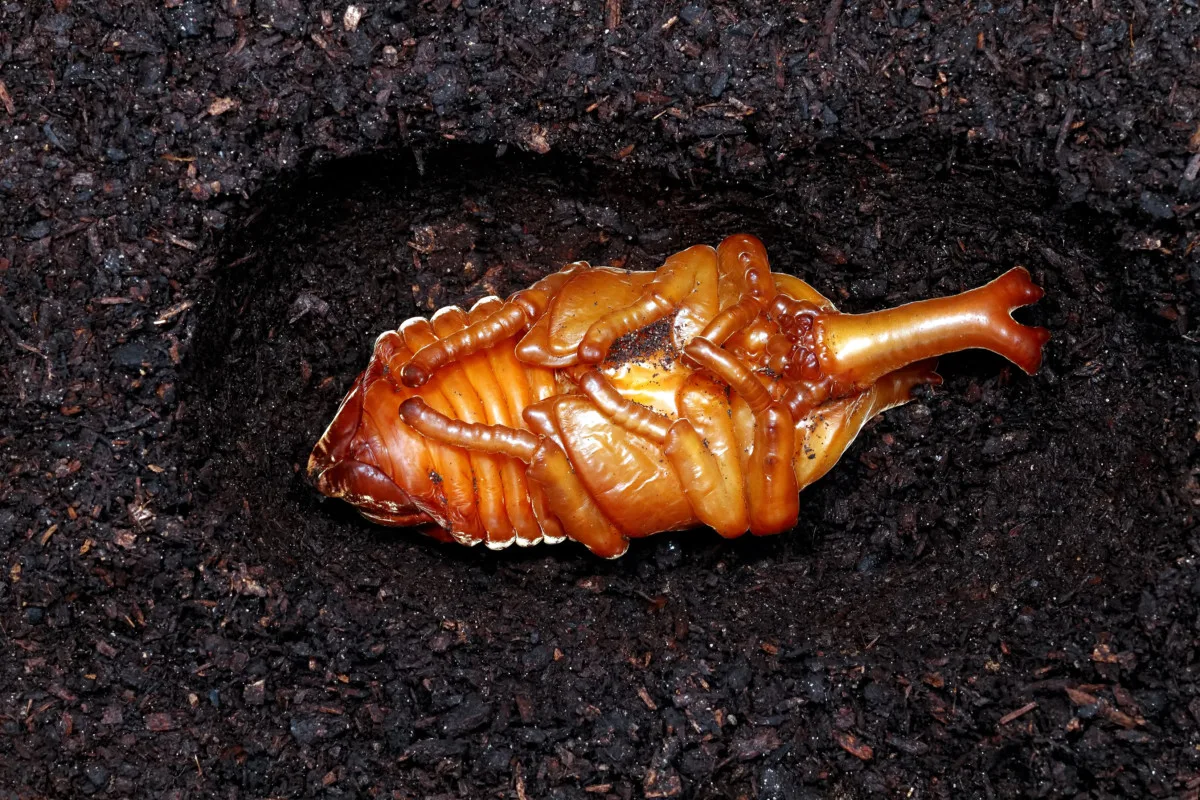
You will rarely see the pupae, as they dwell underground. But the Japanese beetle pupae is a rusty brown color, about ½” long. This is the final stage before turning into the beetle, which will move above ground.
Adult
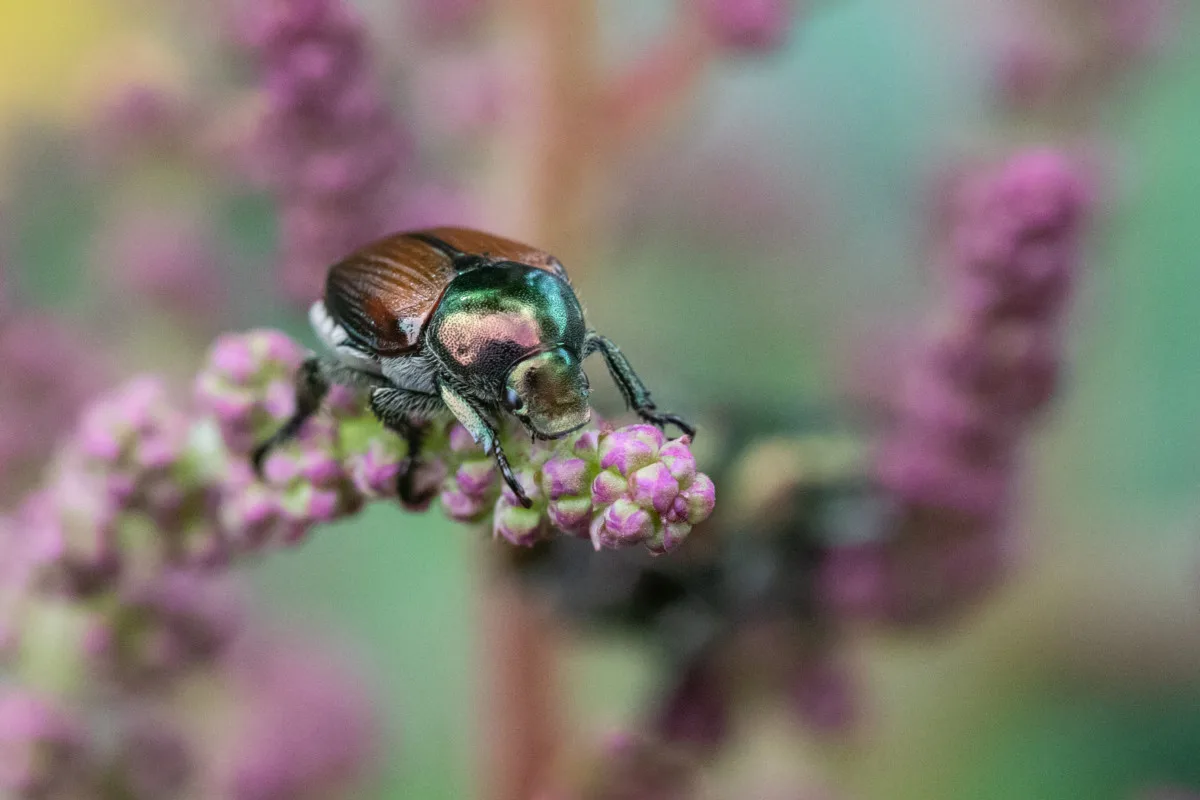
The adult beetle is the most recognized stage and easiest to identify. It also happens to be the most destructive stage. The adults are a little less than a centimeter long and have hard, shiny shells that reflect copper and green in the sunlight. They sport several bristly white tufts along each side of their back. These adult beetles will live for 30-50 days and tend to swarm together. Adult beetles can fly up to two miles to find food.
Depending on your climate, they will appear anytime between May and August.
One of the best things you can do to control Japanese beetles is to reach out to your local agricultural extension office to find out when they start to emerge in your area and when you can expect grub activity after the adults have laid eggs. Knowing these time windows is important for controlling their populations.
What Do They Eat?
Just about everything. At least it seems that way when they show up in your yard. The Japanese beetle feeds on over 400 different species of plants, well over 200 here in the states.
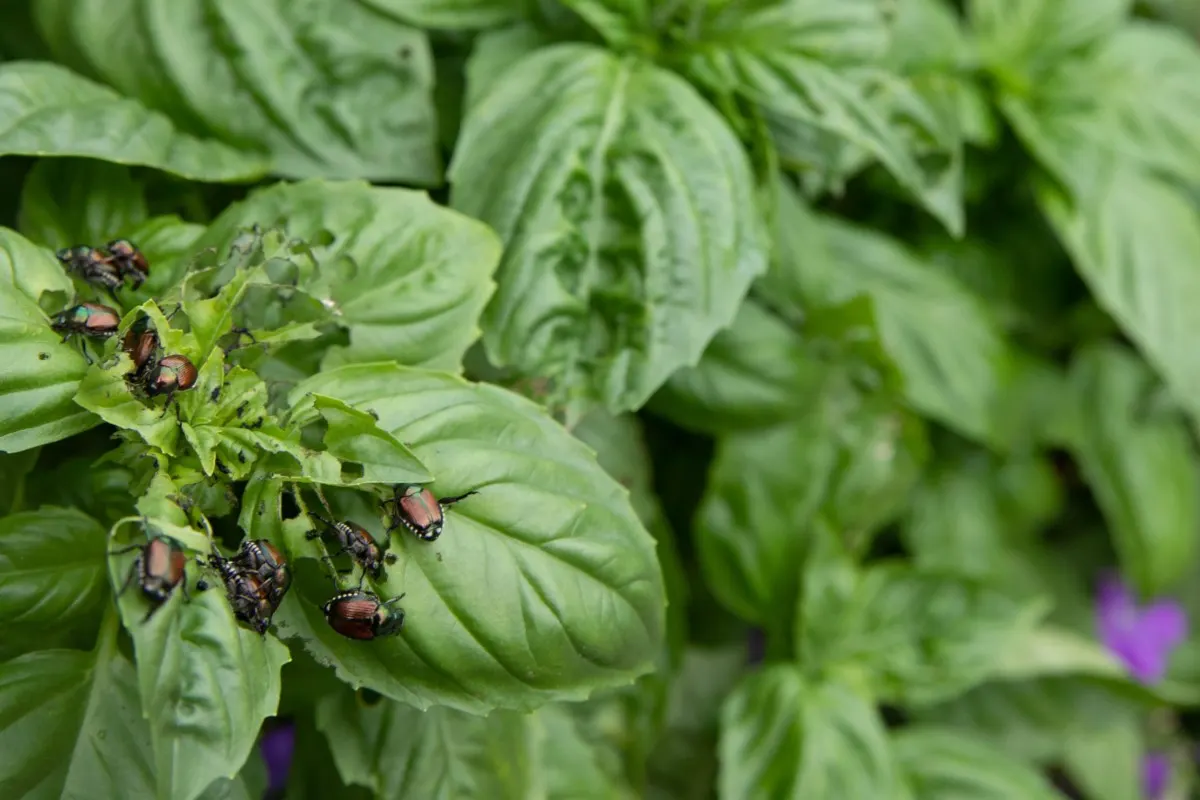
Some of their favorite plants are basil, roses, grapes, flowering crabapple, fruit trees, linden trees, corn silk, ornamental flowers, Japanese maples, vegetable leaves, etc. You know, basically, everything growing in your backyard.
How Long Are They a Problem?
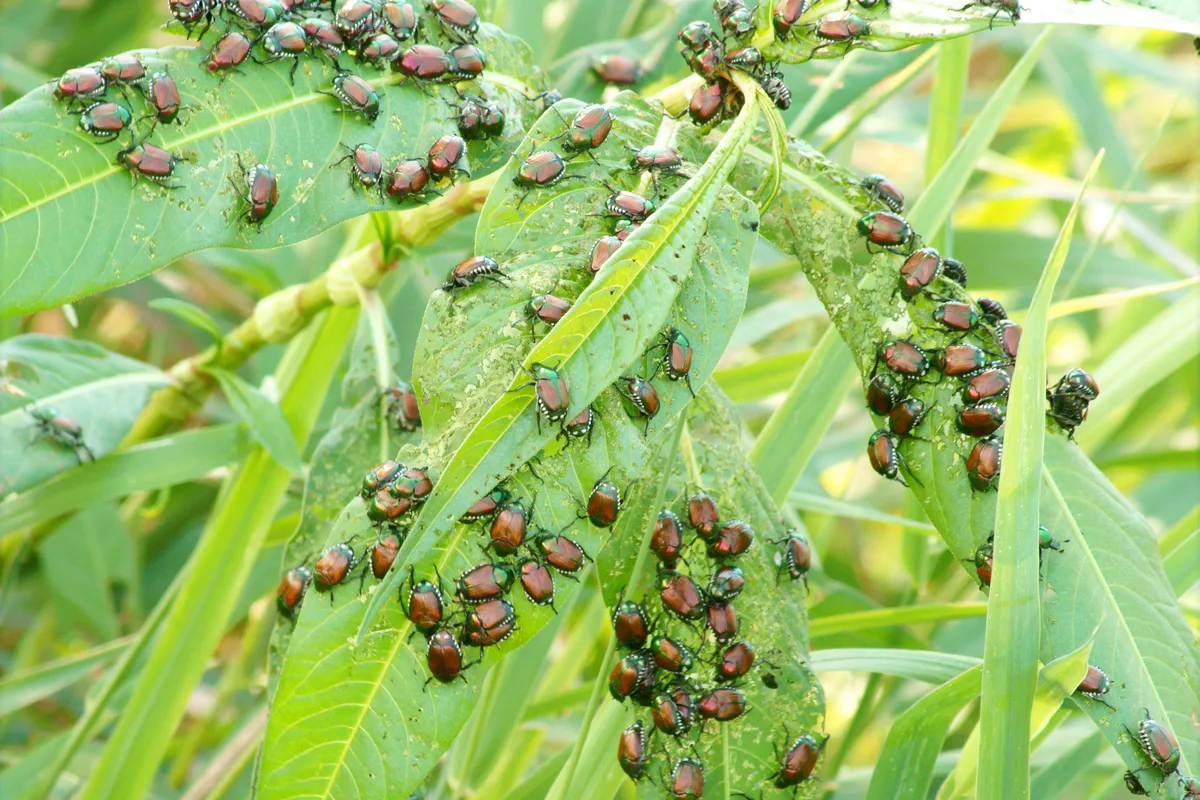
The adult beetles will be around for 4-6 weeks as they devour everything in their path while looking to mate. Once you have a few beetles, they will release a pheromone that lets other beetles know they have found a tasty snack. So, a couple of beetles rarely stay a couple of beetles. It’s incredible how much damage they can do in such a short time. A large enough swarm of beetles can defoliate an entire rose bush in an afternoon.
While most mature trees can handle some Japanese beetle damage, they can easily kill smaller or newer plants. They can also kill your lawn, eating the roots so that with one good heat wave, your grass is toast.
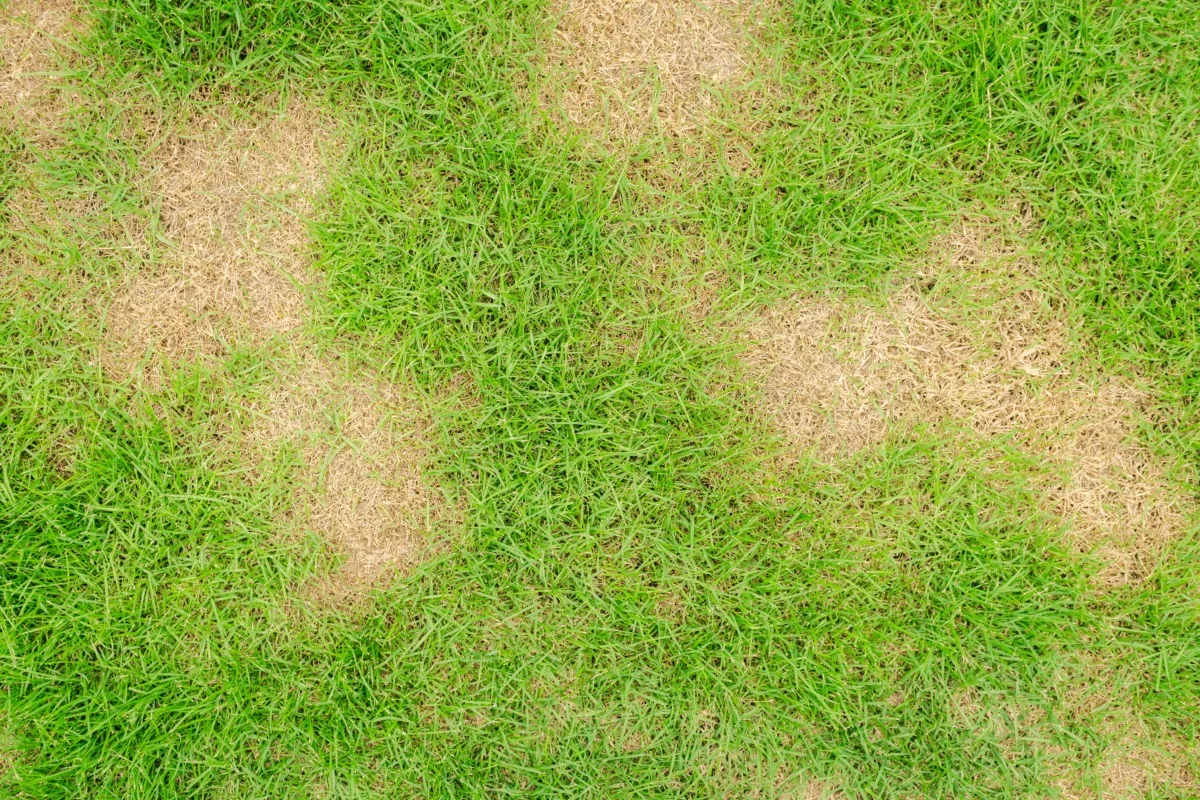
Japanese beetles tend to be cyclical as well. Some years you may not have any, and other years they may come in droves.
Do They Bite?
While nothing is quite so disturbing as feeling a Japanese beetle land in your hair, you don’t need to worry, as they’re incapable of biting. (They don’t have teeth, and their mandibles can only handle soft leaves.) But feeling their bristled, scratchy legs writhe between your fingers is enough to leave you shuddering, which you will most likely do for a good ten minutes after removing the beetle from your hair and stomping it into oblivion.
How to Control Japanese Beetle Populations
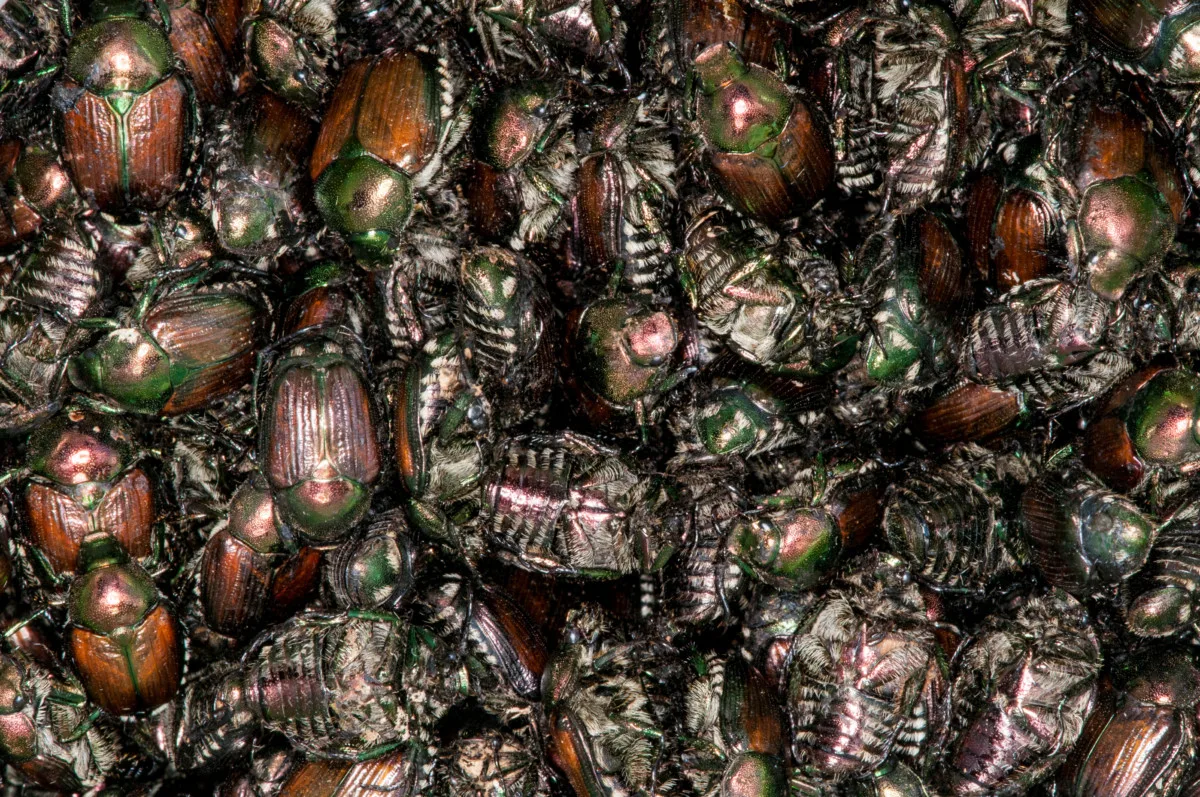
Timing is everything when it comes to your plan of attack. There are two ideal stages of the insect’s life cycle to attack those are in the grub stage and the adult beetle stage. We’ll look at control methods for both, as an exceptionally large infestation may require treatment at both stages.
As mentioned at the start of the article, the most reliable control methods are usually man-made pesticides. Unfortunately, most are quite harsh and kill more than their intended target. For those who are more environmentally minded, we have a bit more work cut out for us, but eradication is not impossible.
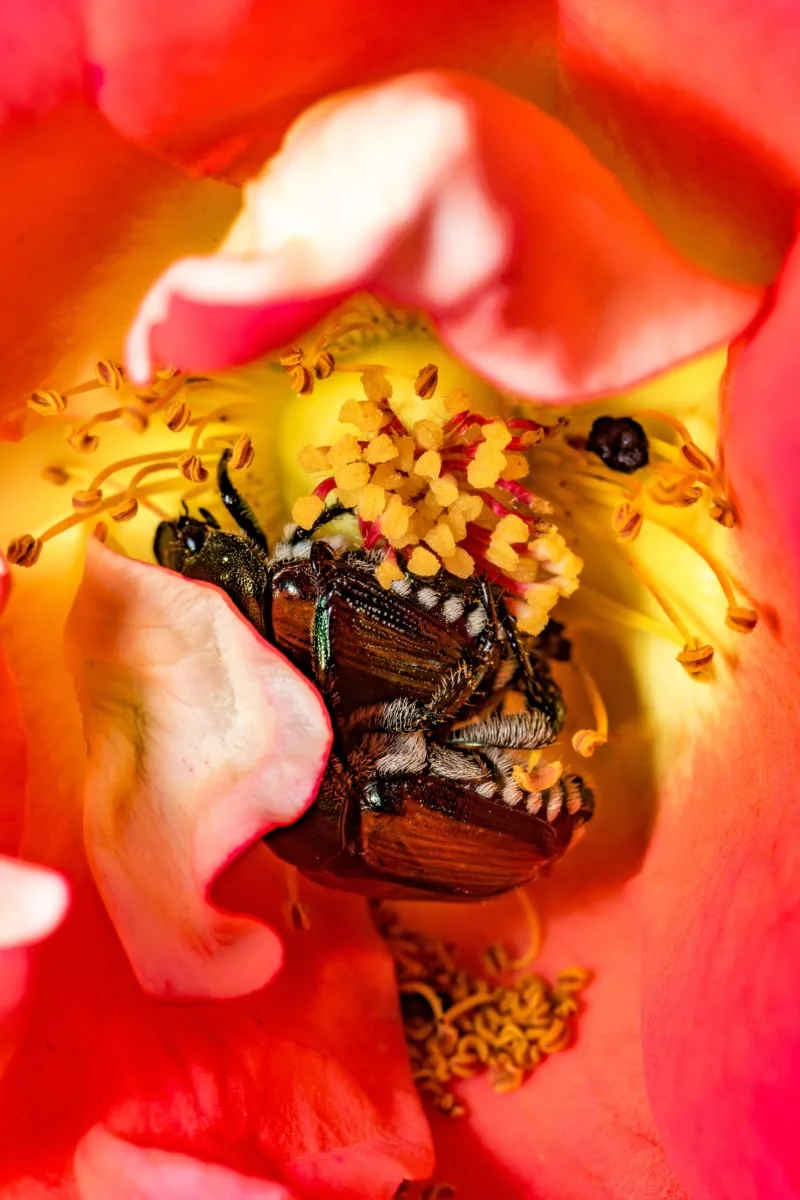
Manual Control Methods
Pick Them Off
One of the simplest and often most effective ways of dealing with a Japanese beetle infestation is to remove them manually from plants as you find them. This is best done in the morning or evening, while it’s cool and the beetles are sluggish and slow. Drop them into a bucket of soapy water to drown.
If you have lots of them on a single plant, a good trick is to carry the bucket and shake the beetles directly into it.
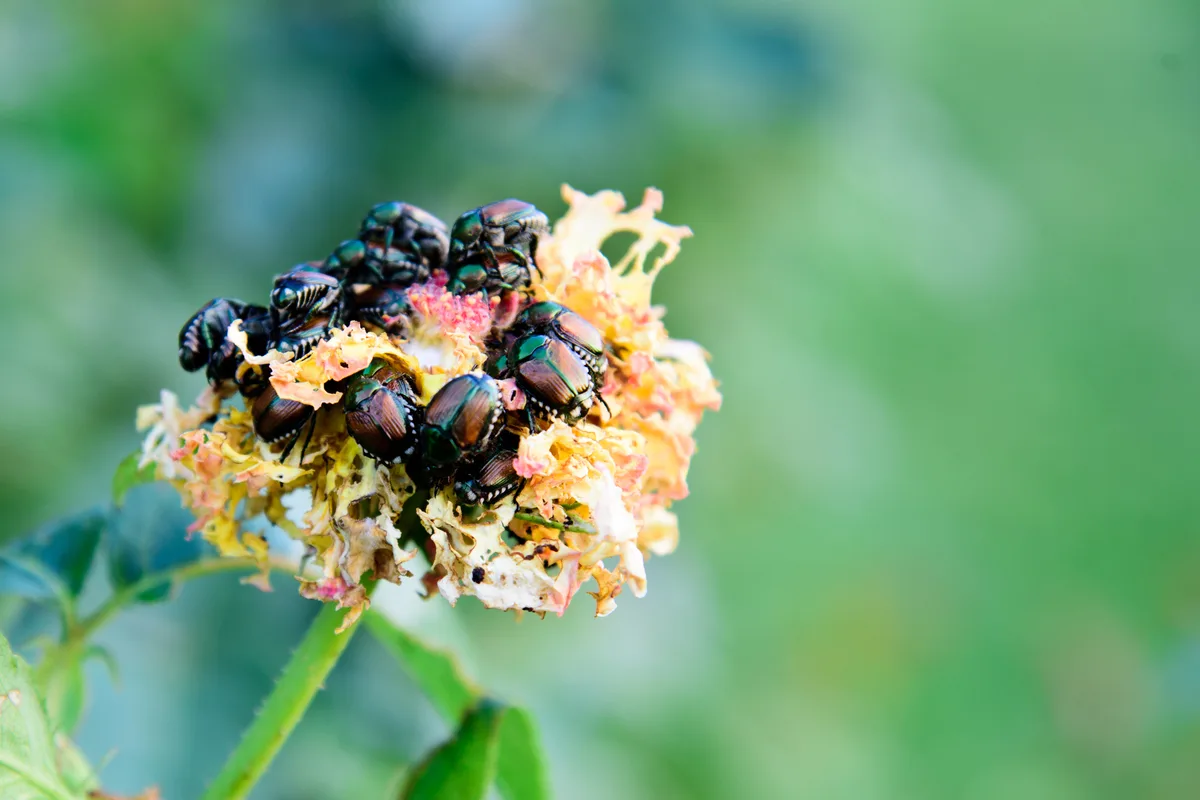
While this method can be quite time-consuming, it is quite effective as a means of organic pest control.
Don’t Water the Lawn
Avoid watering your lawn while the adult beetles are active (mating). Moisture is important to the developing eggs, and fewer eggs will hatch by depriving the soil of moisture.
Protect Ornamentals and Vegetables
You can protect ornamentals, such as rose bushes, from the adult beetles by covering them with a fine netting while the beetles are at their worst. In the vegetable patch, a floating row cover will protect delicate leaves from being defoliated.
Encourage Winged Visitors
Encourage more birds to visit your garden with birdbaths and feeders. Robins, catbirds and cardinals all enjoy these shiny morsels as a snack.
Chickens

If you’ve already been kicking around the idea of a backyard flock, maybe the tipping point comes while watching your prized roses defoliated by Japanese beetles. Chickens are amazing bug hunters and will snack on adult beetles, not to mention other common garden pests.
Change Up the Menu
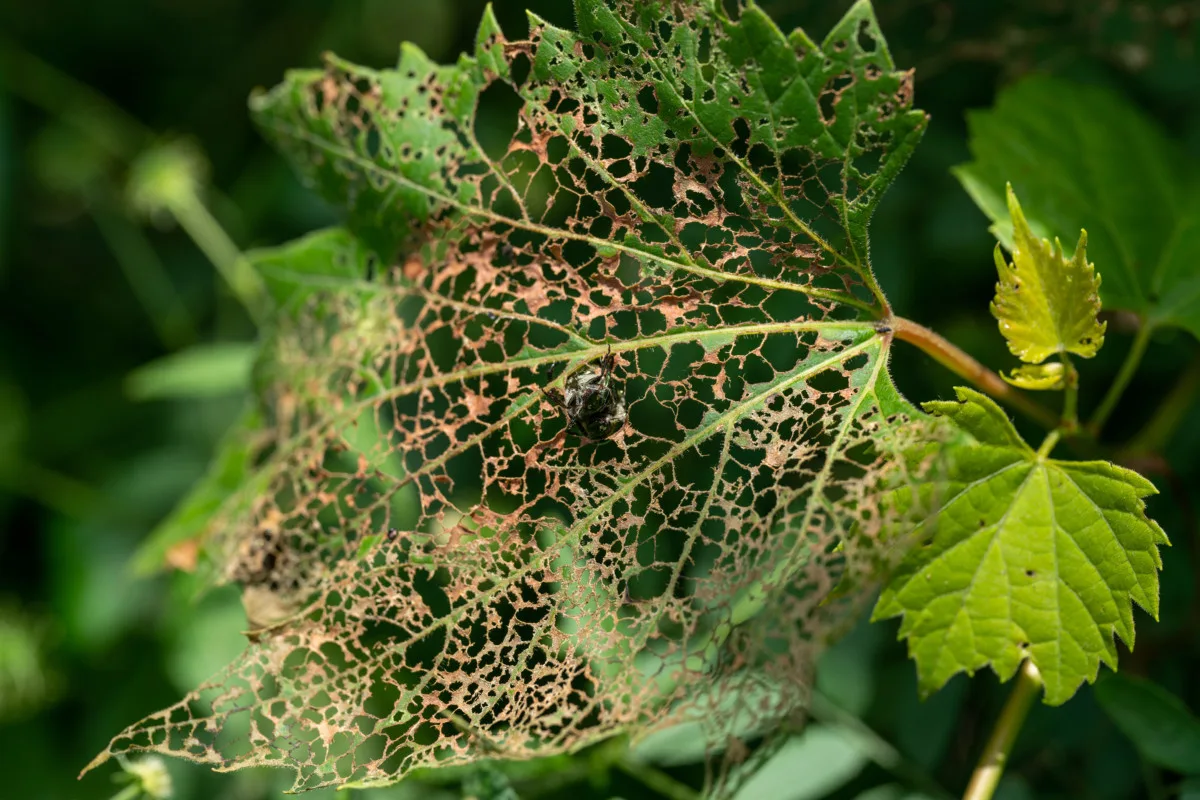
If you’re sick and tired of dealing with Japanese beetles year after year, it may be time to change the menu. We’ve already discussed some of their favorite plants to nibble on, mainly ornamentals and turf. Now, let’s look at some popular landscaping options they’re less inclined to eat. Depending on the severity of the problem, it may be worth your time to remove their favorites from your lawn and replace them with something less appetizing.
To be clear, these plants are not deterrents; rather, an incoming hoard of beetles is less likely to nibble on these plants and look elsewhere for food. Generally, the beetles avoid plants with thick or tough leaves, such as arborvitae, azalea, boxwood, dogwood, firs, hemlock, holly, junipers, lilacs, magnolia, mountain laurel, oaks, pines, redbud, red maple, rhododendron and spruce.
Another point to consider is your lush, green lawn. Japanese beetle grubs feast on the roots of turf grass. If you’re constantly battling with them every year, it may be time to rewild a portion of your lawn. You might also consider a creeping thyme lawn instead of turf.
Organic Insecticides
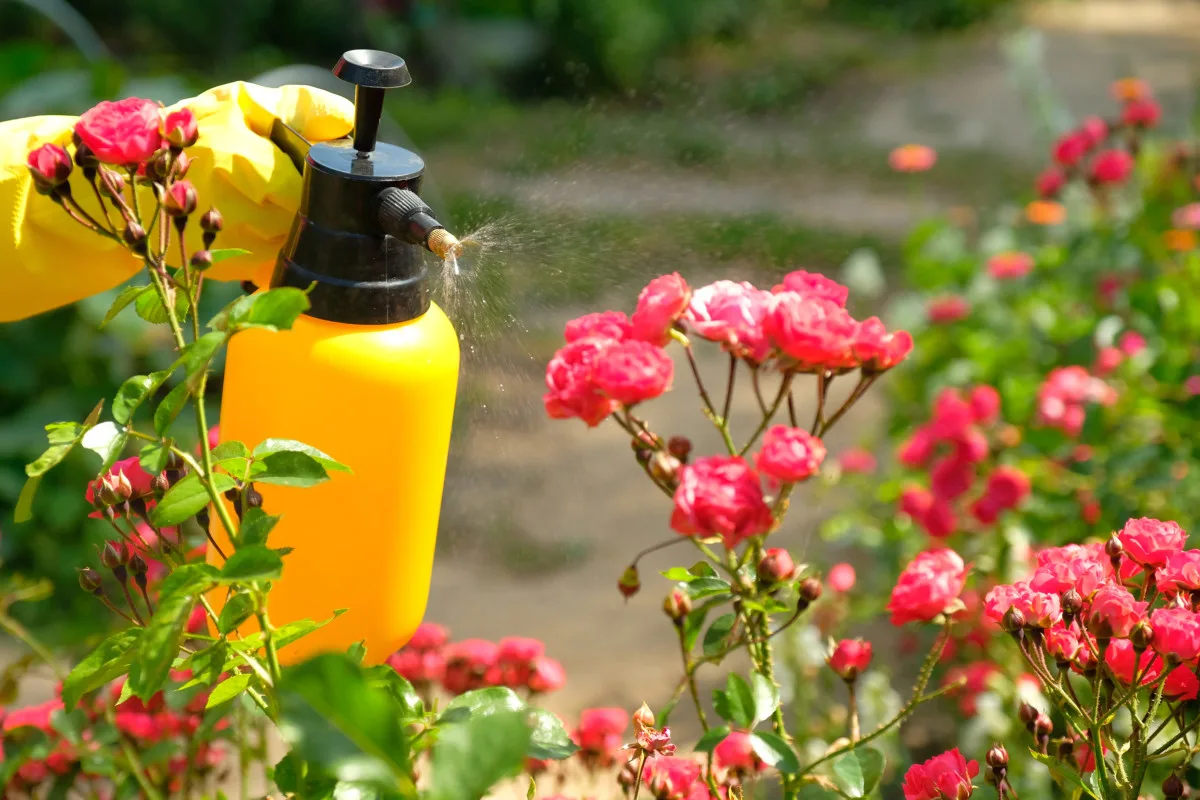
When using an organic insecticide, your two best bets are neem oil and pyrethrin (derived from chrysanthemums). These will effectively kill the adult beetle, larva, and pupa.
Neem oil should be used as soon as you see beetles beginning to emerge. You can mix your own by blending a tablespoon of organic neem oil with a gallon of water. Spray the leaves of ornamental plants or plants where you’ve found beetles or damage. Be sure to saturate the plant completely, including the undersides of leaves.
Only spray neem at night or early morning while flowers are closed to protect your pollinators.
You can also use this mixture as a soil drench to kill other instars of the beetles. Start by saturating the soil around the base of plants that the beetles prefer.
Continue the foliar spray, and the soil drench every week until the beetles disappear. Once the beetles disappear, you may wish to continue the soil drench to deal with any larvae that have hatched. If you notice brown spots on your lawn, peel back a 1’x1’ square to inspect for grubs. Continue the soil drench on these browned areas and about a foot beyond them.
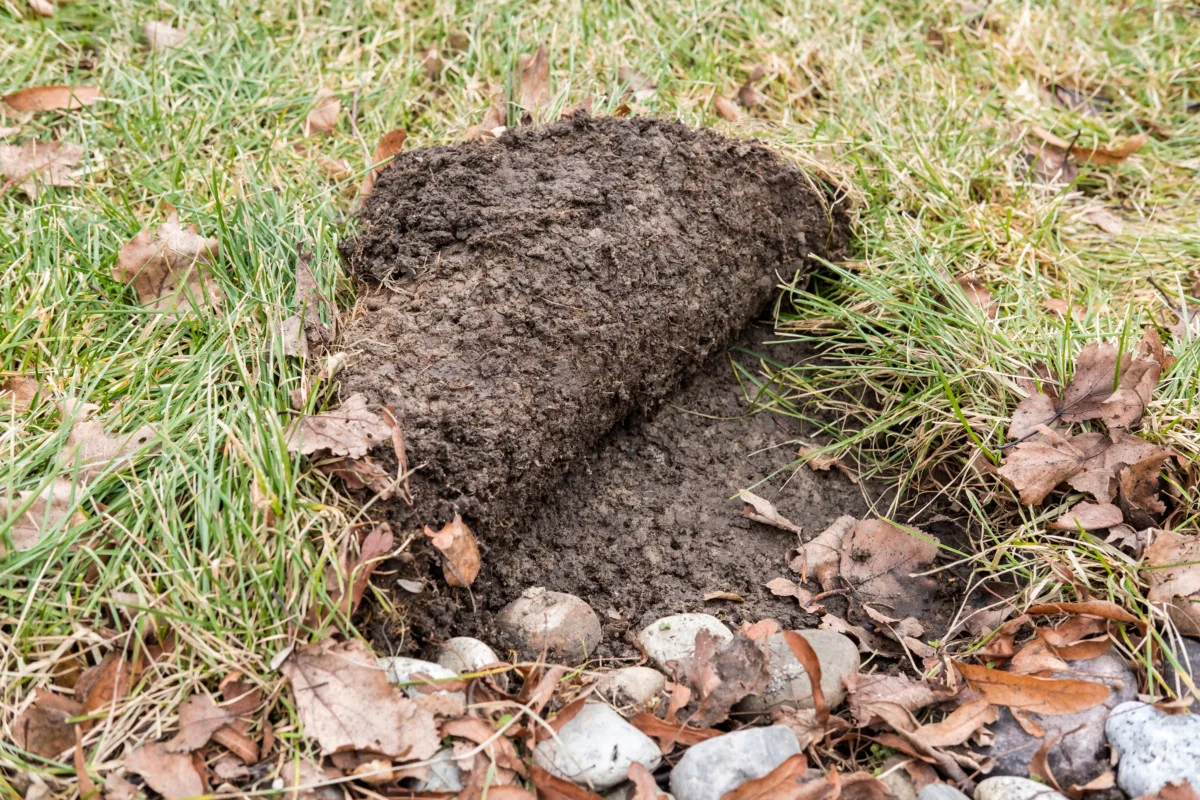
Pyrethrin can be used as a foliar spray in much the same way as the neem oil, but whereas neem oil will be ingested by the beetle, which will kill it, pyrethrin only works if it’s sprayed directly on the beetle. So, it may not be an effective method of control on its own. Pyrethrin is best used alongside neem oil.
Biological Controls
Natural biological controls are your best bet when dealing with Japanese beetles, although patience may be required as they can sometimes take a year or two.
This natural soil-dwelling bacteria, Paenibacillus popilliae, infects the Japanese beetle in its larvae stage, killing the grubs. Once the grub dies, more spores are released into the soil, infecting more grubs. The best part about this particular method of control is that the bacteria spreads exponentially yearly, offering control for up to 15-20 years once it’s established in the soil. The downside is that it requires routine applications every spring, summer and fall for several years to establish the spore presence in your soil.
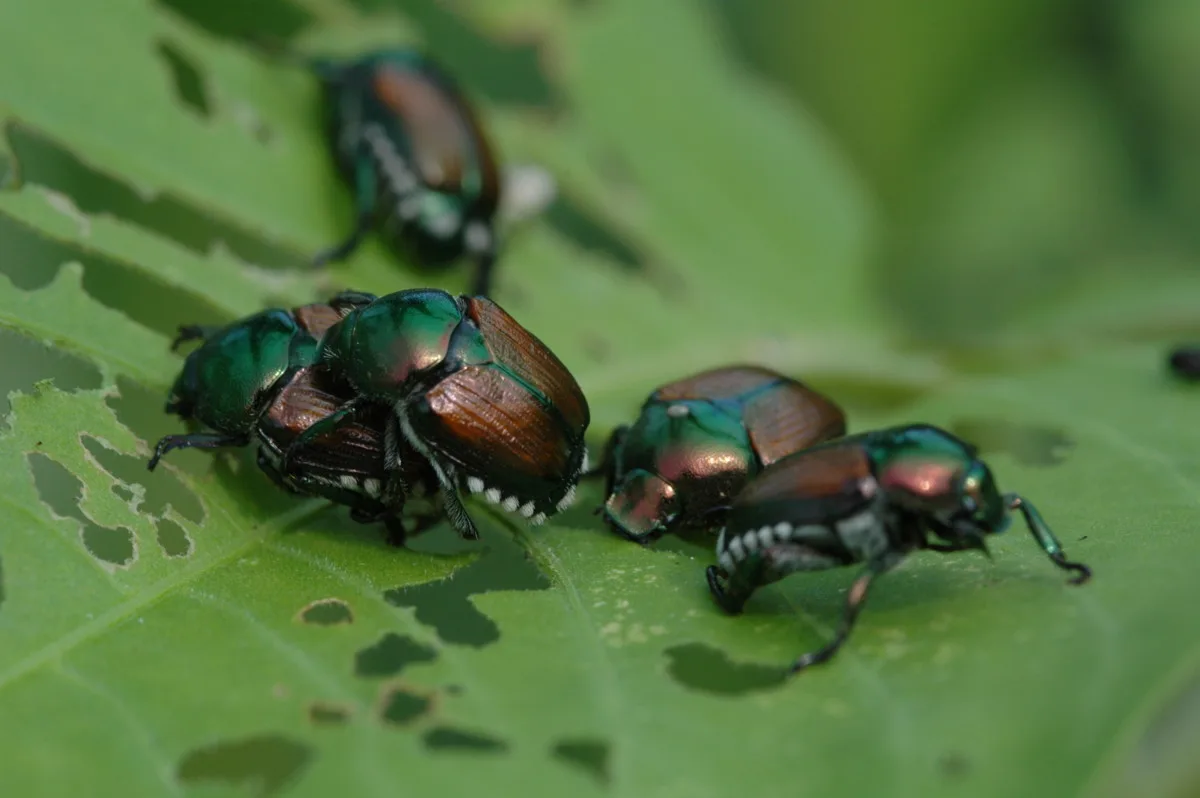
Bacillus Thuringiensis Galleriae
This is another popular microbial control sprinkled on your lawn in a granule form when grubs are active. It infects and kills grubs similar to milky spore. However, this needs to be applied annually. A popular brand of bacillus thrungiensis galleriae is GrubBGone G.
Parasitic Nematodes
Nematodes are microscopic worms present in the soil. While some species can be pests, the heterorhabditis bacteriophora nematode carries a bacterium that will kill Japanese beetle grubs. Using nematodes to kill grubs is an effective, although finicky, solution to Japanese beetle infestations. The nematodes must be refrigerated and require a weekly application to be effective. However, they’re still a good option, especially when used with other control methods.
You apply them to the lawn as a soil drench, watering them into the soil where they will infect the grubs.
To Bag-a-Bug or Not?
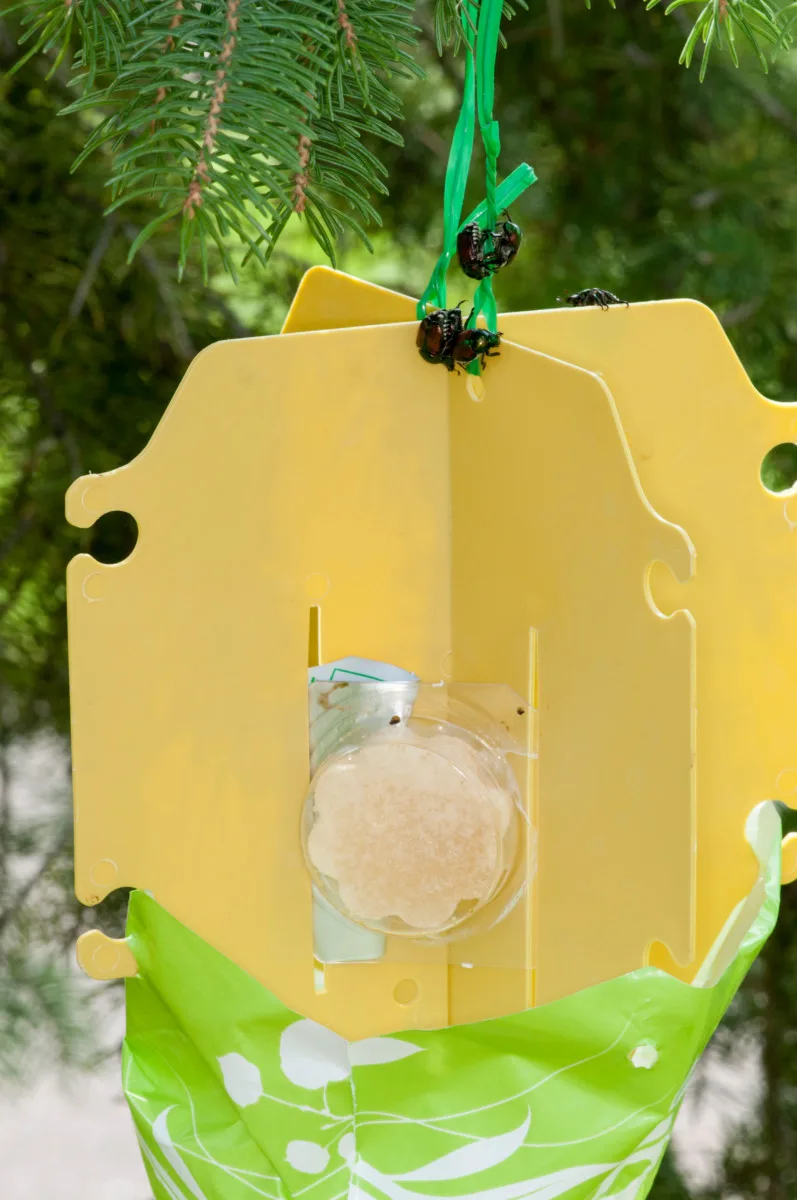
When Japanese beetles emerge in your area, you will likely find hanging bag traps in your hardware store and garden centers. But do they work?
Yes and no.
I worked for a tree care specialist and landscaping company when I first moved to Pennsylvania. I had issues with Japanese beetles in my garden one year, so I bought a bag trap and placed it at the bottom of our small lawn. Telling our pest specialist about my Japanese beetle problem and my solution, he laughed and said, “I’m sure your neighbors are grateful.”
Apparently, all I was doing was drawing more Japanese beetles to my lawn and away from everyone else. For these traps to be effective in luring beetles away from your plants, they must be put far away from your yard. A few hundred yards away. If you have a large lot, this might be doable; otherwise, it’s best to put the bag-a-bug trap in that annoying neighbor’s lawn the next block over.
I’m kidding. Sort of.
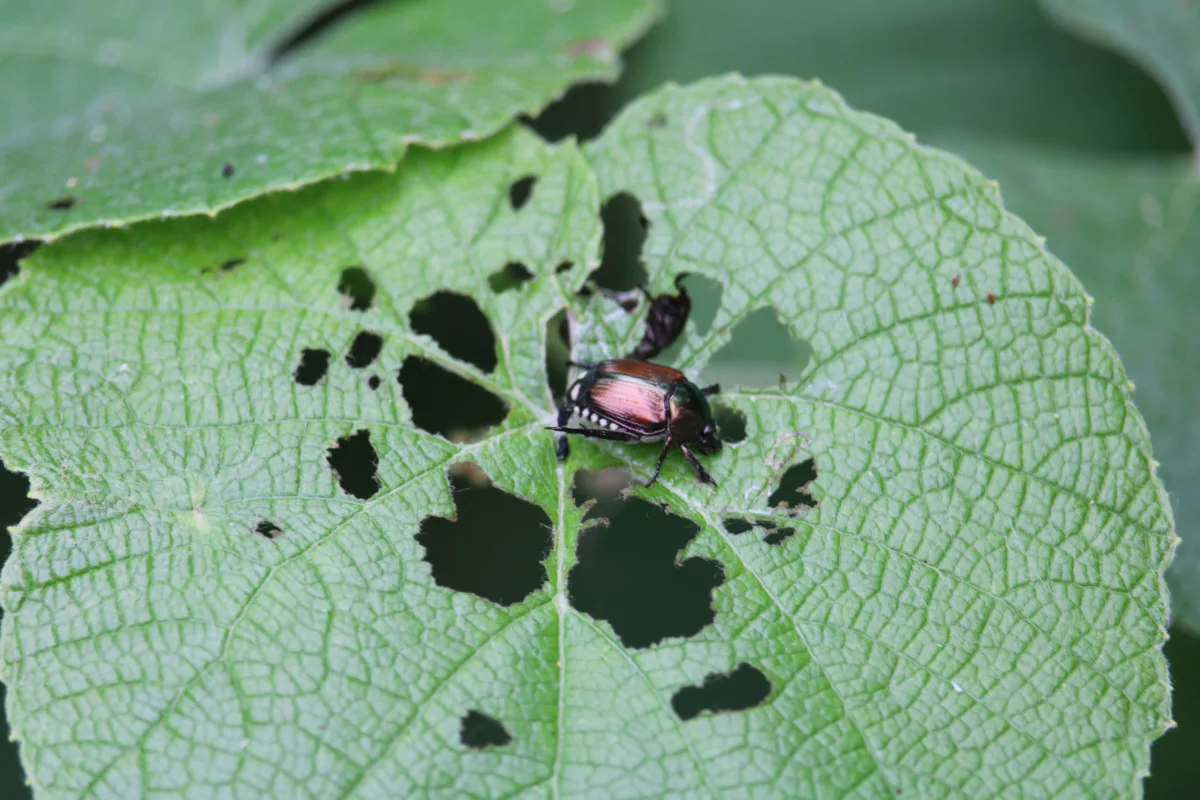
As with many pests, the Japanese beetle requires a multi-faceted approach to win the war. And usually, by the time you get something figured out, they’re gone for the year. But knowing when they show up and the best times to eradicate them can go a long way in preventing further damage this year and every year after.

Get the famous Rural Sprout newsletter delivered to your inbox.
Including Sunday musings from our editor, Tracey, as well as “What’s Up Wednesday” our roundup of what’s in season and new article updates and alerts.

